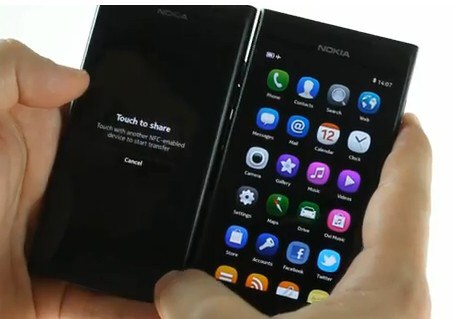The NFC Forum has released its latest specification for the short-range wireless standard, v.16, throwing device to device data transfer into the mixture and the Simple NDEF Exchange Protocol (SNEP) will allow users of NFC-equipped devices to swap content such as business card information, simply by holding their phones together. This could be used to exchange contact information between phones or collect links to trailers from movie posters which could be played back on your TV at home and it’s potentially exciting stuff, so long as manufacturers actually make use of it………………
The NFC Forum, a non-profit industry association that advances the use of Near Field Communication (NFC) technology has released its 16th specification, the Simple NDEF Exchange Protocol (SNEP). SNEP is an application-level protocol suitable for sending or receiving messages between two NFC-enabled devices. The new SNEP specification is available to the public for download at no charge. The SNEP specification was published following an approval ballot of NFC Forum voting members.The extension of the NFC Data Exchange Format (NDEF) to peer-to-peer use in SNEP is a significant advance. Previously, NDEF was applicable only to NFC tags in reader/writer mode. Now, SNEP enables the use of the openly standardized NDEF in peer-to-peer mode, making seamless interchange of data a reality. Application developers no longer need to concern themselves with how their NDEF data gets transferred between NFC-enabled devices. This capability is similar to the way that NFC Forum Tag Type specifications encapsulate the differences between communication layers. By providing this capability, the SNEP specification makes the difference between reader-writer and peer-to-peer operation modes disappear – a major step towards global interoperability of NFC applications. Simplified transfer of contact information – one person’s phone can be configured to automatically send business card information when an NFC peer-to-peer connection is established. The recipient doesn’t have to do anything other than to accept the business card and allow it to be entered into his phone book.
Collecting movie posters for later use – a consumer can retrieve and store movie posters with NFC tags onto an NFC-enabled phone while just passing by. Back home, the consumer can display the movie information on a flat-screen TV and navigate to the films’ web pages, simply by tapping the phone to an NFC-enabled TV remote control. “By extending NDEF to peer-to-peer communications, our SNEP specification adds to the usability of NFC technology and broadens its possibilities, enabling enterprises to offer new, creative, and appealing applications to businesses and consumers,” said Koichi Tagawa, chairman of the NFC Forum. “Specification development is an important part of the NFC Forum’s mission; the extensive suite of NFC Forum specifications is testimony to the hard work of our members, whose activity yields benefits for the entire NFC ecosystem. We are grateful to everyone who participated in the effort to deliver SNEP.” SNEP allows an application on an NFC-enabled device to exchange NFC Data Exchange Format (NDEF) messages with another NFC-enabled device when operating in NFC Forum peer-to-peer mode. The protocol makes use of the NFC Logical Link Control Protocol (LLCP) connection-oriented transport mode to provide a reliable data exchange. SNEP is a request/response protocol. A SNEP client application sends a request to a SNEP server application to either retrieve data from the server with a GET method or push data to the server using the PUT method. The protocol handles segmentation and reassembly of large messages as well as early cancellation of transfers that would exhaust receiving capabilities. Beyond the protocol definition, the SNEP specification defines a default server that is available as a well-known service on an NFC-enabled device. This default server functions as a simple Inbox that applies locally defined processing to received NDEF messages. An NFC-enabled personal computer could, for example, open the web page that is provided in a Smart Poster NDEF message sent from an NFC-enabled mobile phone.
[ttjad keyword=”general”]



